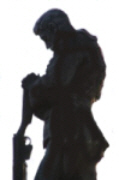



No.301821, Private, Henry William CLARKE
Aged 33

|
Henry William CLARKE was born in Barrow (2nd qtr 1883 Thingoe 4a:633) son of John and Eleanor Ann CLARKE (née DRAKE)
1891 census...Aged 7 he was at the Weeping Willow with his widowed mother Eleanor CLARKE [38] beer retailer born Hawstead; his sisters Eva [12] and Gussie [6] ; brother Edward [10], all the children born Barrow. There was another sister, Lily, born 1878. His father had died in 1889. His mother married Frederick John SYRETT in 1898 1901 census...Aged 16, a carpenter's labourer, he was at 57 The Ham, Brentford boarding with the YOUNG family. His mother and stepfather Frederick TYRELL [33] innkeeper born Haughley; half brother Leslie TRYELL [1] born Barrow; sisters Eva and Augusta (Gussie) were at The Green, Barrow 1911 census...Aged 27, a warehouseman, he was at 12 Ondine Road, East Dulwich with his widower uncle Henry William CLARKE [72] born Hawstead and cousins Arthur CLARKE [32] born Peckham and William CLARKE [30] born Peckham . His mother, stepfather and sisters were still in Barrow His legatee is recorded as his mother Mrs Eleanor SYRETT |

|
He enlisted in Bethnal Green The battalion war diary:- "SUNDAY.In SNAG TRENCH Coys and Raiding Platoon moved up into front line and formed up for an attack. The strength in the front line was then approx Officers 14, other ranks 480 The attack was opened by the artillery about 9:05 am. The barrage was reported to have been distinctly poor, many of the shells falling short. Two white lights were fired in quick succession (signal to lengthen range) without effect. The enemy put up a barrage in front of SNAG TRENCH but it was not intense. Hostile machine gun fire was opended on the first wave as they left the trench and they began falling at once. This machine gun fire came from both right and left The Australians on the right appeared to suffer very heavily from their own artillery fire which also caught several of our men. Their artillery barrage was put up 70 yards to the rear of their own front line and their overhead machine gun fire was hitting our parapet as well as their own. Their attack was consquently a failure on the immediate right. As far as can be ascertained, there was no visible sign of an attack on our left. The travelling over No Mans Land was very heavy but what was left of our waves reached a point within 10 yards of BUTTE TRENCH which was strongly held with men wearing postmans hat with yellow band, others were wearing shrapnel helmets. Our Stokes gun were, as our heavy artillery, falling short and a Lewis gun was completely knocked out by a Stokes gun. Owing to the intensity of the enemy machine gun fire and the trouble with our own heavy artillery, it was found impossible to progress the attack with the few men left. A withdrawal was therefore ordered by the Senior Coy Commander. On the extreme left the 9th Durham LI completley surprised the garrison of the Butte de Warlencourt and were successful in capturing same, but the enemy heavily counter-attacked in the evening and our men withdrew to their original line. During the withdrawal our casualties were very heavy. On completion of the withdrawal there were about 5 officers and 120 other ranks of the Bn in SNAG TRENCH together with a Coy of 5th Border Regt which had moved up when the Bn attacked. During the evening the Bn was relieved by the 5th Border Regt and moved into close support but was immediately relieved by 4th N.F and moved into Reserve on the FLERS LINE. The 5th Borders had received orders to attack the following morning but owing to the situation on the left having altered, the attack was postponed. Patrols reconnoitred the front at night and assisted a number of wounded men." CWGC records the battalion had 104 men killed on 5th, of which 68 have no known grave and are named on the Thiepval Memorial, 34 are buried in Warlencourt
click here to go to the Commonwealth War Graves Commission website for full cemetery/memorial details |